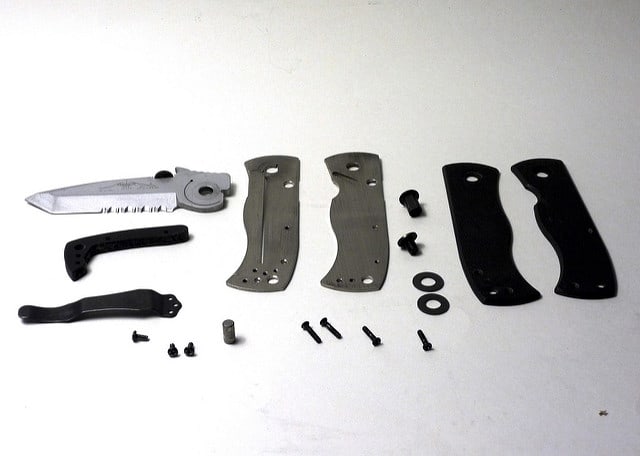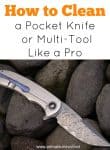Your knife or multi-tool is a critical part of your everyday carry. You love it. You cherish it. And maybe you even show it off once in a while…
But when was the last time you cleaned your pocket knife or multi-tool?
If you feel resistance while opening the knife or tools, or can see visible gunk built up in the pivots, then it has already been too long!
Step 1: Remove Lint and Gunk
Using a toothpick, remove any visible bits of gunk you see trapped in the pivots or handle. Don’t worry about doing a thorough cleaning with the toothpick. That will come later.
The knife should always be dry during this first step. If you try to poke out lint while it is wet, it could get more stuck in the pivot and harder to remove later.
If you have it, compressed air (such as for cleaning computer keyboards) is also good for removing lint from within the knife.
As shown in this video, a putty knife can also be used to get gunk out of the crevices of a pocket knife.
Step 2: Wash the Knife with Soapy Water
Now is the time to get your knife really wet and remove any stickiness on it. Pay close attention to the locking mechanism and pivot. You want to make sure any dirt or crud is washed out.
You can use a sponge or soft-bristle toothbrush to wash the knife. However, never use anything abrasive to clean your knife! Not even the abrasive side of the sponge!
I prefer to use q-tips for cleaning the inside parts of the knife. Here’s a cool tip: Use a hammer to flatten the end of the q-tip and you’ll be able to get further inside of the knife.
For multi-tools, you’ll need to open and close each tool individually to clean them. Take your time and be sure to clean as you pivot out the tool – some parts of the tool only become exposed as its pivots out.
Step 3: Don’t Be Afraid to Soak the Knife
If your knife has a lot of crud built up in it (you probably waited too long to clean it, huh?), don’t be afraid to give it a good soak in sudsy water.
Use very HOT water as this will dissolve sap, dirt, and sticky residue. Just don’t do anything foolish like adding boiling water. The water should be hot, but not so hot that it will destroy your knife handle.
Cover the edge of your knife with tape before you scrub it. This will prevent you from accidentally cutting yourself while it is slippery with soap and water. Trust me, those knife cuts really hurt – especially when the soap enters the cut!
Step 4: If Any Dirt Remains
For really tough spots, put a few drops of rubbing alcohol on a q-tip and rub off the dirt. The alcohol should evaporate really quickly, but I still rinse the spot anyway.
Step 5: Don’t Disassemble the Knife
As tempting as it can be to take apart your knife to get to those bits of gunk in the pivots, do not disassemble!
In almost all cases, disassembling will void your knife warranty. Instead, call the knife company. Some good knife manufacturers will have you send them your knife so they can professionally clean and sharpen it for you.

Step 6: Let the Knife Dry Completely
Yes, COMPLETELY. If even a little bit of moisture is still only your knife, it can lead to corrosion or destroy the handle (especially in the case of wooden knife handles).
Step 7: If There Is Rust on the Blade
Even “stainless” steel knives still develop rust sometimes. This doesn’t mean that your knife is ruined. When rust forms, it is usually just on the surface. At this point, it likely hasn’t caused any irreparable damage. If you wait too long though, then the rust will cause pitting in the blade and destroy it.
So take care of that rust the moment you see it!
There are a lot of different products on the market for removing rust, some of which are made especially for knives and multi-tools. Two of these are:

In a pinch, you can use WD-40. However, most pros recommend one of the other products.
To remove the rust, put a small amount of the rust remover on a q-tip. Then rub this onto the affected part of the knife.
Try not to get the rust remover on other parts of the knife! It can be really hard to remove from these areas!
Let the rust remover sit for a few minutes. Then scrub it with a mildly-abrasive pad (the green ones on dish sponges work well – don’t use anything grittier than this).
If you can’t get the rust off in one try, then reapply the rust remover, let it sit, and try again. Be patient! It might take a few tries before the rust is completely removed.
Once you get the rust removed, completely wash and dry the knife again. The last thing you want is traces of rust remover left on your knife.
Step 8: Oil Your Knife
Pocket knives and multi-tools have a lot of moving parts including pivots and locking mechanisms. You’ve got to keep them lubed if they are to work reliably each time.
What Type of Oil to Use on a Knife?
There is a lot of debate about what the best type of oil for a knife is. Here are some points to remember:
- For knives that will be used on food, only use edible oil. So, no WD-40! Mineral oil is a good option.
- For knives that will not be used on food, 3-in-1 oil works great. Break-free CLP is another great choice.
- Avoid vegetable oil and motor oil.
- To prevent dust and debris from sticking to your knife, consider using a “dry” lubricant. One option is Finish Line Dry Teflon. Bike stores have many types of dry lubricants. Firearm stores are also a good place to find quality lube.
- If you don’t mind paying extra for a quality knife lube, consider FirePower FP-10, or Sentry Solutions Tuf-Glide. Both are highly recommended and don’t attract dirt.
Applying the Oil
The most important thing to remember is that you only need a tiny drop of oil for your knife. Putting too much oil on your knife will actually attract dirt and can lead to corrosion.
To apply the oil:
- Apply the oil as close to the center of the pivot and locking mechanism as possible.
- If the bottle doesn’t have a mechanism for delivering the oil precisely, use a toothpick to apply the oil.
- An even better method of applying oil is to get a 1cc medical syringe.
- After applying the oil, open and close the knife so the oil gets worked into the pivot.
- Don’t get oil on the handle! It will make it very slippery. Rubber handles will especially absorb the oil and could make them slippery for a very long time.
How Often to Oil?
This depends on how often you use your knife.
- Always oil your knife after cleaning it.
- When not using a knife, oil it every 2-3 months.
- You’ll need to oil the knife more often if it is humid or you’re near saltwater.
- Always oil your knives before storing them.
There you have it – how to clean and oil your folding knife or multi-tool. Remember to take care of those babies and they’ll take care of you when you need them. BTW, if you are looking for a good knife, check out these Best Survival Knives for Under $100. You’ll probably also like these Awesome EDC Essentials.
How often do you clean and oil your knives? Any tips you want to share — let us hear them in the comments!




It seems to happen a lot. Almost every time I read or view an online instructional guide, the one question I have is around something mentioned but not explained.
In this case, it’s the abrasive-related thing. I can GUESS why, but it’s still 50/50.
Please elaborate – not sure what you are asking here?
Reece F: You should not put a good knife in a dishwasher. The chemicals and heat can ruin a good knife. A hint for fixed blade knives: don’t store them in a leather sheath. It holds moisture and will rust your knife.
One word…DISHWASHER.
Any quality multitools or knives should be perfictly fine in tge dishwasher…mine get this treatment every 6-12 months for the last 10 years. All are well and function perfectly.